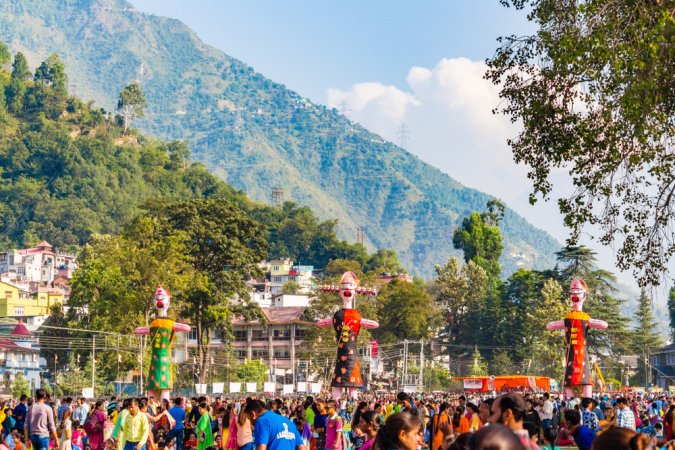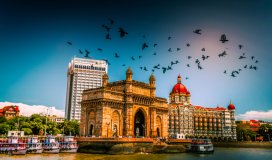Dussehra Celebration in India 2018 : A Comprehensive Guide
Dussehra is also known as Vijayadashami and is observed at the end of Navratri. The festival is celebrated uniquely in different parts of the country and for different reasons. It marks the end of Durga Puja as well as the end of Ramlila. No matter where you go in India, Dussehra is celebrated with great vigour and marks the victory of good over evil. It is celebrated on the 10th day of the Hindu month of Ashwin. The ten-day long celebrations include Ramlila performances, pujas and fairs (melas). People go to see the Ramlila where people enact scenes from the Ramayana.
Ravana Dahan takes place on the last day, and the effigies of Ravana, Meghnath and Kumbhakarna are burnt amidst cheers. Ravana is shown with ten heads, and each of them stands for negative emotions that need to be conquered. However, Ravana refused to let go of his heads or those negative emotions, when he was told to do so by King Mahabali, as per the mythology. Dussehra reminds one how it is the inability to control one’s emotions and desires lead to the ultimate destruction.
The famous Dussehra celebrations in India reflect unity in diversity across the country. It is celebrated in different parts of the country in different ways. One finds people praying, feasting and enjoying the fireworks. On this day you get a glimpse of traditions and communal celebrations. As most Indians love festivals, they delight in every aspect of Dussehra, which means different things to different people. The whole nation takes on the veneer of ethnic elegance during Dussehra and looks and feels special.
People enjoy going to fairs where they can enjoy rides, shop for knick-knacks, enjoy street food, games and other fun activities. Sometimes there are cultural performances too. Every nook and corner is lit up brightly and carries a festive mood.
The legend behind Dussehra
As per Hindu mythology, the sister of the demon Ravana fell in love with Rama and Lakshmana. She wanted to marry one of them but they refused and cut her ears and nose. Ravana avenged the insult of his sister by abducting Sita, Rama’s wife. Rama and Lakshmana fought a battle with Ravana with the help of Lord Hanuman and his army of monkeys to rescue Sita.
Apart from Ramayana, Mahabharata too carries a reference connected with the celebration of Dussehra. Pandavas fought with the evil forces with different unique weapons. Later, while leaving for their exile, they abandoned their weapons under the Shami Tree. After the period of exile was over, they retrieved their weapons from the very same place where they had hidden them under the Shami tree. Thus they bowed and worshipped the tree. The day of worshipping is marked as the time of Dussehra festival.
Dussehra also marks the victory of Goddess Durga over the demon Mahishasura and his comrades Chanda and Munda. The fight went on for 9 days and on the 10th day, the goddess killed them near a hill and hence got the name Chamundeshwari and the hill came to be known as Chamundi Hill, in Mysore.
Popular Dussehra Celebrations in Different destinations of India
Dussehra celebrations in some cities of India are famous for their exciting and exceptional ways. Apart from the cities mentioned below, Dussehra celebrations in India in Delhi, Lucknow, and Mumbai are also popular.
1. Kolkata gets completely transformed into the city of joy during the Dussehra festival. There are elaborate pandals across the city, dhunuchi dance and delectable bhogs to enjoy. Kolkata’s Durga Puja Pandals get the limelight.

Kolkata’s Durga Puja Celebration
2. Chennai gets decked up with brightly-coloured tableaux made of idols of gods and goddesses. The kolus display several themes from Ramayana and Mahabharata. The day marks creativity and innovation and is celebrated with great enthusiasm.
3. Dussehra in Mysore is celebrated with much pomp and show to commemorate the killing of demon Mahisasura by warrior goddess Chamundeshwari. The Mysuru palace is spectacularly lit in the evening.

Dussehra in Mysore
4. Kullu Dussehra is very famous as it celebrates the centuries-old festival with spiritual fervour. The sonorous calls of trumpets and beats fill the crisp Himalayan air as 200 local deities and demigods participate in Lord Raghunath’s rath yatra.

Dussehra Celebration in Kullu
5. Dussehra in Bastar, Chhattisgarh is celebrated in a unique 75-day festival, and the origin of the tradition can be traced back to 13th century. The days are all about spirituality and prayers.
6. The Ram Lila performance in Varanasi is perhaps the most famous and has been carried out at the Ramnagar Fort since the early 1800s. The fort gets transformed into a stage to represent different episodes from the epic saga.
7. In Gujarat people enjoy Navratri and Dussehra by performing and enjoying the special Gujarati dance ‘Garba’. Both men and women dress in traditional clothes to enjoy this celebration.
Also Read: Diwali Long Weekend Plan
You may come across Ganga Dussehra and might wonder if it is the same as Dussehra or any different. Ganga Dussehra is also referred to as Gangavataran and celebrates the descent of the river Ganges. It is believed that the holy river Ganges ran down from heaven to Earth on this very day. However, the festival has no link with the more popular Dussehra festival.
Also Read: Durga Puja Celebrations in Kolkata
October and November months are a period of endless festivities, and the Dussehra festival is one where cities come alive with excitement and celebration. There is incredible energy in the air as people get ready for more festivities after Dussehra like Karwa Chauth, Diwali and Bhai dooj. This is the best time to visit India, and know about its culture and festivities.
Suggested Read: Places To Visit in October in India

